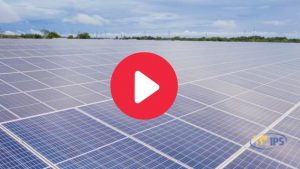Video: Roraima in Search of Safe and Sustainable Energy Autonomy
 7 Februari 2023
7 Februari 2023

By Mario Osava
BOA VISTA, Brazil, Feb 6 2023 (IPS)
Roraima, the northernmost state of Brazil, on the border with Guyana and Venezuela, is undergoing an energy transition that points to the dilemmas and possible solutions for a safe and sustainable supply of electricity in the Amazon rainforest.
As the only state outside the national grid – the National Interconnected Electric System (SIN) – it is dependent on diesel and natural gas thermoelectric plants, which are expensive and polluting sources, that account for 79 percent of Roraima’s electric power.
The financial and environmental cost is exacerbated by the transportation of fossil fuels by truck from Manaus, the capital of the neighboring state of Amazonas, 780 kilometers from Boa Vista, the capital of Roraima.
But the people of Roraima pay one of the lowest prices for electricity in Brazil, thanks to a subsidy paid by consumers in the rest of the country.
These subsidies will cost about 2.3 billion dollars in 2023, benefiting three million people in this country of 214 million people, according to the National Electric Energy Agency regulator.
A fifth of the total goes to Roraima, which from 2001 to 2019 received electricity imported from Venezuela. This meant the state needed less subsidies while it enjoyed a degree of energy security, undermined in recent years by the deterioration of the supplier, the Guri hydroelectric plant, which stopped providing the state with energy two years before the end of the contract.
Fortunately, Roraima has natural gas from deposits in the Amazon, extracted in Silves, 200 kilometers from Manaus, to supply the Jaguatirica II thermoelectric power plant, inaugurated in February 2022, with a capacity of 141 megawatts, two thirds of the state’s demand.
Roraima thus reduced its dependence on diesel, which is more costly and more polluting.
But what several local initiatives are seeking is to replace fossil fuels with clean sources, such as solar, wind and biomass.
This is the path to sustainable energy security, says Ciro Campos, one of the heads of the Roraima Renewable Energy Forum, as a representative of the Socio-Environmental Institute (ISA), a pro-indigenous and environmental non-governmental organization.
The city government in Boa Vista, the state capital, home to two thirds of the population of Roraima, has made progress towards that goal. Solar panels cover the roofs of the city government building, municipal markets and a bus terminal, and form roofs over the parking lots of the municipal theater and the Secretariat of Public Services and the Environment.
In addition, a plant with 15,000 solar panels with the capacity to generate 5,000 kilowatts, the limit for so-called distributed generation in Brazil, was built on the outskirts of the city.
In total there are seven plants with a capacity to generate 6,700 kilowatts, in addition to 74 bus stops equipped with solar panels, some of which have been damaged by theft, lamented Thiago Amorim, the secretary of Public Services and the Environment.
In addition to the environmental objective, solar energy allows the municipality to save the equivalent of 960,000 dollars a year, funds that are used for social spending. Boa Vista describes itself as “the capital of early childhood” and has won national and international recognition for its programs for children.
The Renewable Energies Forum and the Roraima Indigenous Council (CIR), which promote clean sources, say the aim is to reduce the consumption of diesel, a fossil fuel transported from afar whose supply is unstable, and to avoid the construction of the Bem Querer hydroelectric plant.
The project, of which there are still no detailed studies, would dam the Branco River, Roraima’s largest water source, to form a 519-square-kilometer reservoir that would even flood part of Boa Vista. It would affect nine indigenous territories directly and others indirectly, said Edinho Macuxi, general coordinator of the CIR.
Bem Querer would have an installed capacity of 650 megawatts, three times Roraima’s total demand. It has awakened interest because it would also supply Manaus, a metropolis of 2.2 million inhabitants that lacks energy security, and could produce more electricity just as the generation of other hydroelectric plants in the Amazon region is declining.
Almost all of Roraima is in the northern hemisphere, and the rainiest season runs from April to September, when water levels run low in the rest of the Amazon region. The state’s hydroelectricity would therefore be complementary to the entire Brazilian portion of the rainforest.
That is why Bem Querer is a project inextricably connected to the construction of the transmission line between Manaus and Boa Vista, already ready to start, which would integrate Roraima with the national grid, enabling it to import or export electricity.
“We can connect, but we reject dependency, we want a safe and autonomous energy model. We will have ten years to find economically and politically viable solutions,” said Ciro Campos.
